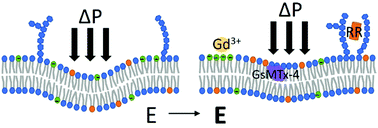Mechanosensitive ion channel inhibitors promote the stiffening of the plasma membrane of mouse sensory neurons†
Abstract
The mechanosensitivity of cells depends on the lipid–protein interactions of the plasma membrane. Affectations in the lipid region of the plasma membrane affect the transduction of mechanical forces, and any molecule that modifies the biophysical integrity of the lipid bilayer can alter the mechanical activity of the proteins inside the membrane. To understand whether inhibitors of mechanically activated ion channels affect the mechanical properties of the plasma membrane, we evaluated the rigidity of the membrane of sensory neurons of the DRG of mice using a variant of the scanning ion conductance microscopy method, which allows us to calculate the Young's modulus of individual cells before and after the perfusion of different doses of Gd3+, ruthenium red and GsMTx-4. Our results suggest that these molecules compromise the membrane by increasing the Young's modulus value, which indicates that the membrane becomes more rigid; these compounds act through different mechanisms and by a non-specific manner, each one shows a certain preference for specific cell subpopulations, depending on their cell size and their reactivity to isolectin B4. Our results support the idea that the biophysical properties that result from the interactions that arise in the membranes are part of the mechanotransduction process.

- This article is part of the themed collection: Celebrating Latin American Talent in Chemistry


 Please wait while we load your content...
Please wait while we load your content...